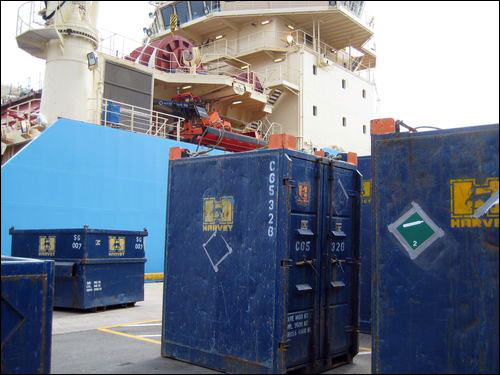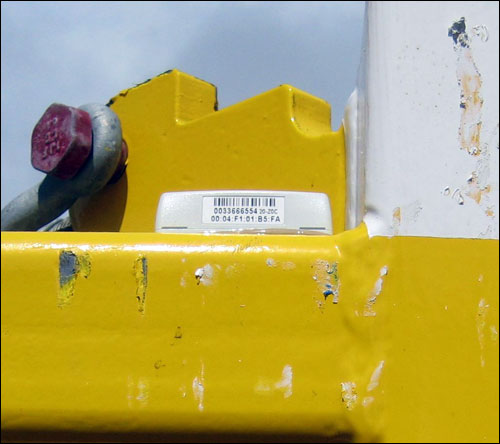Jul 22, 2010A. Harvey, a Canadian provider of marine and offshore oil and gas support services, is installing an active real-time locating system (RTLS) to locate and track the movements of containers as they are stored and then moved onto and off of vessels destined for oil rigs in the northern Atlantic Ocean. The installation follows a four-month pilot to test the active tags and readers in the harsh environment of the Newfoundland coast, thereby ensuring the tags could sustain the weather at sea and withstand impacts as containers are moved or jarred.
IDBlue is installing and providing integration for the system, provided by Zebra Enterprise Solution (ZES) and consisting of active 2.4 GHz RFID tags, readers and ZES Visibility Server Software (VSS). The company sought an end-to-end container-management system for use at its location at the Newfoundland port in its marine base, where containers are loaded onto and off of vessels, as well as at its container depot, where empty containers are stored and maintained or repaired.
A. Harvey provides movement of all items to and from offshore oil rigs, including piping, food, tools and garbage. The firm operates a 13-acre site, including A. Harvey's marine base and container depot in Newfoundland, where containers destined for the firm's five oil-platform customers are stored, loaded and unloaded. The containers loaded with cargo travel approximately 220 miles from the shore to the rig, and then back again—a 14-hour journey, round-trip, under cold, wet and windy conditions. Until the new system was installed, A. Harvey manually tracked which containers were shipped and returned, as well as where they were stored at the base, while also manually listing items loaded in each container. The company has a total of 1,400 to 1,500 containers in 30 different form factors.
The challenge for IDBlue, the firm reports, was to provide an RFID system that could track the locations of containers at the base, monitor when the containers are moved onto and off of vessels, and withstand the harsh environment of the open sea off the Canadian coastline. The company selected the ZES system, which included tags, readers and software.
In the fall of 2009, IDBlue and A. Harvey commenced design work for the system. Then, beginning in February of this year, it conducted a pilot of 50 adhesive Zebra WhereTag IV tags, compliant with the ISO 24730-2 RTLS standard. The tags, attached to 46 containers, two trucks and two ships for one oil company, beacon at a rate of every four minutes. For the pilot, IDBlue installed one ZES WherePort exciter, which transmits a signal that activates the tags, as well as one interrogator on the roof of a guard hut. This reader receives the active RFID tags' transmission, including a tag's unique ID number, along with a date and time stamp. The tags can be read at a distance of 5,700 feet, but for the purposes of the RTLS, the read range needed to be about 3,200 feet in order to enable the system to locate containers with "slot-level" accuracy—that is, within 10 feet throughout the base station. The VSS software, running on a standalone dedicated server, interprets the tags' locations, and that information is then forwarded to A. Harvey's enterprise resource planning (ERP) system.
Based on the pilot's, success, the full installation—consisting of tagging all containers, along with additional trucks and vessels, for the participating customer, and then eventually tagging the containers and vessels for all of its customers—is now underway, says Jeff Brown, IDBlue's VP of services. "A part of the pilot was to understand whether our gear was rugged enough for the environment," says Paul Baboian, Zebra Enterprise Solutions' business development manager. The pilot, he indicates, found that the tags could, indeed, sustain the harsh sea environment.
Since the pilot ended in June, A. Harvey has begun tagging its 1,400 containers, as well as additional vessels and vehicles. The VSS software will display a map of the marine base and the container depot—and in the case of the marine base, it will also provide the location of the container, tagged vessel or truck within approximately 10 feet. At the container depot, where knowing a container's precise location is less critical since it is not being prepared for loading onto a vessel, readers at the entrance and exit capture the ID number of each container's tag, indicating that container is in the depot, but not providing the exact slip in which it is stored.
Geoff Cunningham, A. Harvey's manager of offshore operations, indicates the system will offer the company visibility of containers at the base, as well as shipment and automated shipment and receipt confirmation for each container as it is loaded onto a vessel and later returned. It will also enable the firm to track the length of time containers remain in holding prior to being shipped, and the time spent offshore. "The system will primarily be used to locate containers more quickly," Cunningham states. "This will confirm location of containers needing certification [approval from government agencies that monitor the safety of goods going to offshore oil rigs] and location of containers to be loaded on vessels, thus decreasing load time of the vessel."
A. Harvey plans to fully integrate the VSS system with the company's current ERP system. Design work for that integration is currently underway, Brown says, with full integration expected to take place in the fall of 2010. Once that has been accomplished, the company will be able to not only track containers, but also link each container's ID with its contents. In this way, the system could be used for invoicing, allowing A. Harvey to generate an invoice for the supplied items once the system indicates the container has been shipped. The solution could also be utilized for inspection management. For example, A. Harvey's staff could use the VSS software to run a search for containers requiring inspection in the coming days, and then receive a listing of those containers, as well as their locations. At that time, vessel tags could be used to confirm which container is loaded onto which ship. The system will be fully deployed with all containers tagged by the end of the year.




